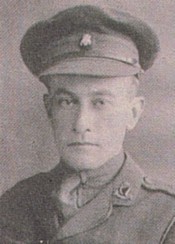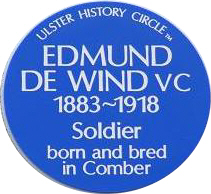Edmund De Wind facts for kids
Quick facts for kids
Edmund De Wind
|
|
|---|---|
 |
|
| Born | 11 December 1883 Comber, County Down, Ireland |
| Died | 21 March 1918 (age 34) near Grugies, France |
| Allegiance | |
| Service/ |
Canadian Army |
| Years of service | 1914 – 1917 (Canada) 1917 – 1918 (UK) † |
| Rank | Second Lieutenant |
| Unit | 15th Battalion, The Royal Irish Rifles |
| Battles/wars | World War I – German spring offensive |
| Awards | Victoria Cross |
Edmund De Wind (born December 11, 1883 – died March 21, 1918) was a brave British Army officer from Ireland. He fought during World War I, also known as the First World War. He was given the Victoria Cross after he died. This award is the highest and most respected honor for showing extreme bravery in battle. It is given to soldiers from the United Kingdom and Commonwealth countries.
Both his home country of Northern Ireland and his adopted country, Canada, remember Edmund De Wind as one of their heroes who earned the Victoria Cross.
Early Life and Joining the War
Edmund De Wind was born in Comber, County Down, Ireland, on December 11, 1883. His parents were Arthur Hughes De Wind and Margaret Jane De Wind. He went to Campbell College for school. After finishing school, he worked for the Bank of Ireland in a town called Clones.
In 1914, when World War I began, Edmund De Wind was living in Canada. He worked for a bank called CIBC in Edmonton.
He first joined the Canadian military, serving with The Queen's Own Rifles of Canada. Then, in November 1914, he officially joined the 31st Battalion-Alberta Regiment as a private. He arrived in France with the Canadian forces in September 1915. He fought in important battles like the Battle of the Somme in 1916 and at Vimy Ridge in 1917. In September 1917, he became an officer in the British Army.
His Victoria Cross Story
Edmund De Wind was 34 years old when he earned the Victoria Cross. He was a Second Lieutenant in the 15th Battalion of The Royal Irish Rifles. He received the award for his incredibly brave actions on March 21, 1918. This was during a major German attack called the 1918 Spring Offensive. He died on that very day.
His award citation describes his bravery:
For most conspicuous bravery and self-sacrifice on the 21st March, 1918, at the Race Course Redoubt, near Grugies. For seven hours he held this most important post, and though twice wounded and practically single-handed, he maintained his position until another section could be got to his help. On two occasions, with two N.C.O.'s only, he got out on top under heavy machine gun and rifle fire, and cleared the enemy out of the trench, killing many. He continued to repel attack after attack until he was mortally wounded and collapsed. His valour, self-sacrifice and example were of the highest order.
—The London Gazette, 13 May 1919
This means he bravely defended a very important position for seven hours. He was wounded twice and almost alone. But he kept fighting until help arrived. Twice, with only two other soldiers, he climbed out of the trench under heavy enemy fire. He fought off the enemy and cleared them from the trench. He kept fighting off attacks until he was badly wounded and could no longer continue. His courage and willingness to sacrifice himself were truly amazing.
How He Is Remembered
Edmund De Wind is remembered in several places.
- His mother had a pillar made with his name and date of death. It is at the main entrance of St Anne's Cathedral, Belfast. The entire front of this cathedral is a memorial to the people from Ulster who served and died in World War I.
- His name is also on the Pozières Memorial in France. This memorial remembers soldiers from the Fifth Army who went missing during the war.
- There is a special plaque at his old school, Campbell College, in Belfast.
- In his hometown of Comber, a blue plaque was put up in 2007 by the Ulster History Circle to honor him.
- A mountain in Alberta, Canada, is named Mount De Wind after him.
- A group of houses in Comber is also named in his honor.
See also
- List of Canadian Victoria Cross recipients



